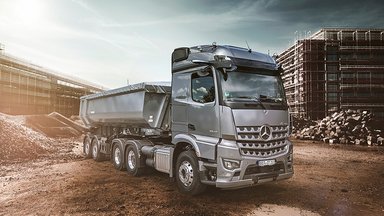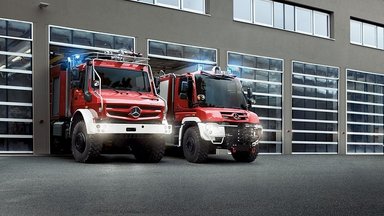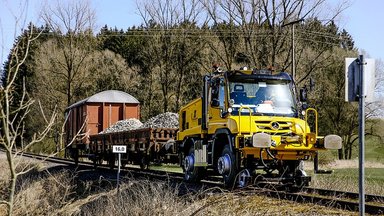
Reinforcement for extreme situations: Stuttgart Fire Department relies on all-terrain Unimog
Download
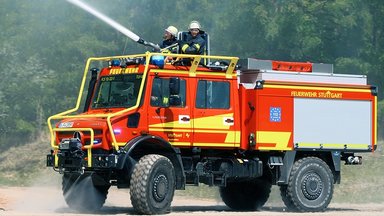
Reinforcement for extreme situations: Stuttgart Fire Department relies on all-terrain Unimog
The Stuttgart Fire Department procures four new Unimog for emergency management operations like fighting forest fires. One new addition to the fleet is a rescue vehicle based on Unimog U 323 with just 2.20 meters width for use on narrow roads in forest and vineyard. In addition, procurement of two identical water tenders TLF-W and one rescue vehicle RW-HG based on the all-terrain Unimog 5023. These four new vehicles can be…
- The Stuttgart Fire Department procures four new Unimog for emergency management operations like fighting forest fires.
- One new addition to the fleet is a rescue vehicle based on Unimog U 323 with just 2.20 meters width for use on narrow roads in forest and vineyard.
- In addition, procurement of two identical water tenders TLF-W and one rescue vehicle RW-HG based on the all-terrain Unimog 5023.
- These four new vehicles can be used to form a tactical unit in combination with two older Unimog.
- 35 firefighters train on the four new Unimog at the off-road testing grounds in Ötigheim for deployments with extreme off-road conditions.
Leinfelden-Echterdingen / Wörth am Rhein / Ötigheim – Drought and dryness with a higher risk of forest fires on one hand, and unusually heavy rainfall, high water, and floods on the other: In the context of climate change, extreme weather has come to be one of the greatest challenges faced by fire departments and disaster relief services. The Stuttgart Fire Department recently decided to purchase a total of four new Mercedes-Benz Unimog. The rescue vehicles U 323 RW-K (compact) and U 5023 RW-HG (extreme off-road capable) provide technical assistance, while the two identical Unimog U 5023 TLF-W water tenders are used to transport extinguishing agents off road. These four new Unimog are equipped with Varus 4x4 fire truck bodies from Schlingmann, a specialty supplier of firefighting equipment.
Dr. Georg Belge, Stuttgart Fire Department Chief: "The topographical situation in Stuttgart and the surrounding area, with the mountains, valleys, steep slopes, and narrow roads, means that firefighting vehicles must be suited for extreme off-road operations. As such, the Unimog’s high off-road capability was a decisive factor during our procurement process, because it enables us to act quickly and effectively as a tactical unit in the event of a disaster or accident."
Stuttgart: Setting up a tactical unit for firefighting and disaster-relief
Combined with two older water tenders based on the U 1250, these four new Unimog can form a task force. As the only one of its kind in Germany, the objective of this tactical unit is to effectively combat dangerous vegetation/forest fires as well as to provide disaster relief in the event of flooding. The fire department's Unimog complement one another well, with the rescue vehicles (RW) providing technical assistance and the water tenders (TLF-W) rapidly delivering water for forest fires and the. This tactical unit's Unimog will be used by the Stuttgart Fire Department for operations in the region and beyond. They are stationed at the Stuttgart volunteer fire department stations in the districts of Uhlbach (U 323 RW-K), Degerloch (U 5023 RW-HG), Heumaden and Büsnau (the two U 5023 TLF-W).
Training for operations on challenging terrain
At the end of July, 35 Stuttgart volunteer firefighters trained, under the supervision of the Stuttgart Fire Department, on using these four new Unimog in the event of an emergency. In the so-called "gravel pit", a site with challenging conditions used to test off-road vehicles in the municipality of Ötigheim, Baden-Wuerttemberg, these firefighters had a chance to gauge and become familiar with the Unimog's off-road capabilities in extreme situations under the guidance of experienced trainers.
The Unimog’s operational capability through sand, mud and water, over tree trunks, down winding slopes, and up the steep ramps of the Unimog test site, which are up to 35 degrees, was met with an enthusiastic response by all participants. "The Unimog exceed our requirements for off-road capability," said Christian Schwarze, Head of the Technology Department at the Stuttgart Fire Department. "The off-road training provided by the manufacturer in Ötigheim gave our drivers the opportunity to experience how the vehicle handles in extreme situations, and it did a great deal to build our confidence in the Unimog’s operational capabilities. It was a complete success – I saw happy faces everywhere in the gravel pit!"
Fast approach on narrow roads with first compact rescue vehicle (RW-K)
Of special note is the first compact rescue vehicle (RW-K) based on the all-wheel drive U 323 4x4 from the Unimog implement carrier series. It is designed for a crew of three firefighters and has a chassis width of only 2.20 meters. This enables the vehicle to reach most deployment areas quickly as Stuttgart has many wine-growing and forest areas with very narrow and steep roads and paths. Thanks to the U 323's high traction, providing assistance and initiating rescue measures is possible all year round, even in adverse weather.
The Unimog U 323 RW-K has a total weight of 12.7 tons, a wheelbase of 3.60 meters, and differential locks on the front and rear axle, both of which are portal axles. It features an automatic shift manual transmission (EAS) with an off-road group and engine output of 170 kW (231 hp). Moreover, it has an increased trailer load of up to 20 tons to tow a center-axle trailer. Sufficient illumination of the deployment area is ensured by two LED headlamps on the cab roof, the surround lighting with additional LED spotlights on the front body corners, and the pneumatic light tower. This vehicle is also equipped with an air conditioning system that protects the crew from heat and prevents the windows from fogging in cold weather. Like all four new Unimog, the U 323 also has branch deflectors to prevent damage as well as a winch on the front of the vehicle. As with all rescue vehicles, its main duty is to provide technical assistance.
The body frame is made of special welded stainless steel profiles. Tools and other gear are stowed in equipment compartments, pull-outs, drawers, and holders, which are illuminated by LED. On board, the vehicle has chain saws and reciprocating saws, cut-off machines, sappies, peaveys, lift pads, a lever, choker cable, stretcher, hydraulic rescue kit, and protective clothing for the crew. In addition to a multipurpose ladder, a 230V charger, and batteries, the roof box also has space for a flag set and equipment used for rough cleaning of the site. The firefighting equipment of the compact U 323 RW-K also includes a portable, manual mechanical gripper with a pulling force of 16 kN.
New U 5023 RW-HG all-terrain rescue vehicle
Its all-terrain capability, 14.5 ton gross vehicle weight, 3.85 meter wheelbase, 170 kW (231 hp) engine output, and automated manual transmission with off-road group are just as much part of the characteristic features of the Stuttgart Fire Department's new Unimog U 5023 RW-HG as the all-steel cab for a three-person crew, the torque tube technology of the portal axles with 100% effective longitudinal/transverse differential locks, or the pipe rupture protection of the brake system.
The body's design and the equipment for providing technical assistance are essentially the same as the U 323 RW-K. However, the portable gripper on the U 5023 RW-HG has a higher tensile load of 32 kN. Like the two TLF-W, the RW-HG is equipped with a tire pressure control system. The air pressure, and thus the tire's contact surface, can be adjusted with the push of a button when driving on different surfaces, allowing the vehicle to move steadily on both asphalt access roads and sandy or muddy ground. With a fording capability of 1.2 meters, the rescue vehicle – like the two TLF-W – can be used in flooded areas. In addition, all three U 5023 vehicles are capable of carrying up to ten people on the roof of the body in order to bring them to safety.
Newly designed: two Unimog U 5023 TLF-W water tenders
The Stuttgart Fire Department has the first two vehicles of a new type, which is specifically designed to fight vegetation/forest fires and can also be used for water disasters. Both vehicles feature the remarkably low Varus 4x4 body from Schlingmann in a stainless steel/aluminum composite design with a very low center of gravity. The T-shaped extinguishing water tank, which has a volume of 3200 liters, is integrated into the body. The crew cabs each have space for a four-person firefighter crew including protective clothing and equipment. Two side equipment compartments and one rear equipment compartment are provided for storing necessary firefighting equipment. Roof boxes and other storage systems can also be used for additional space. Besides the tire pressure control system, the wheels are equipped with beadlock rims in order to meet the specific requirements of driving on recently burnt vegetation, for example.
Using the pump and roll technique, up to 2,000 liters of extinguishing water per minute can be dispensed from two roof hatches above the rear seats. When driving through a forest fire, the vehicle crew is kept safe and sound by the front spray bar as well as the spray nozzles in front of all four wheels and on the cab's branch deflector. In especially dangerous situations, the crew can use the engine-independent
self-protection system, which is fed with 230 liters of water via two separate safety tanks. This vehicle is also equipped with a centrifugal fire pump with venting device, a 60-liter foam tank for a wetting agent admixture (reduces the surface tension of the water so that it can better penetrate into the burnt material), and 20 pressure hoses.
The Unimog U 5023 TLF-W also features water tank heaters, infrared cameras, and intercom systems that allow interference-free communication. Additional safety is provided by special heat shield sheaths for lines used with the operation. The front and rear headlamps, surround lighting on the roof, and special signaling system feature LED technology to ensure better visibility in the dark or adverse weather.
Article assets
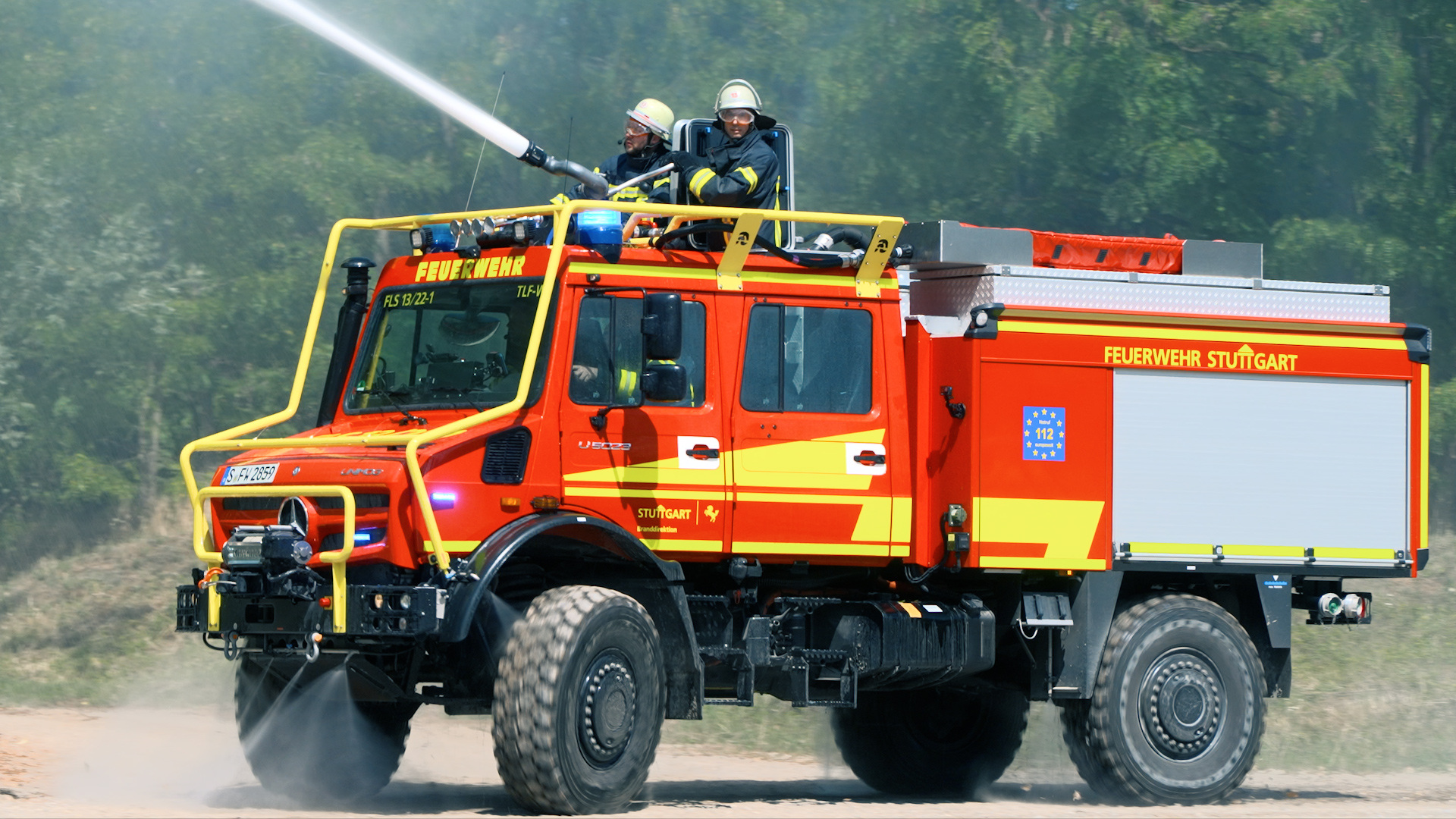
Reinforcement for extreme situations: Stuttgart Fire Department relies on all-terrain Unimog

Reinforcement for extreme situations: Stuttgart Fire Department relies on all-terrain Unimog

Reinforcement for extreme situations: Stuttgart Fire Department relies on all-terrain Unimog

Reinforcement for extreme situations: Stuttgart Fire Department relies on all-terrain Unimog

Reinforcement for extreme situations: Stuttgart Fire Department relies on all-terrain Unimog

Reinforcement for extreme situations: Stuttgart Fire Department relies on all-terrain Unimog

Reinforcement for extreme situations: Stuttgart Fire Department relies on all-terrain Unimog

Reinforcement for extreme situations: Stuttgart Fire Department relies on all-terrain Unimog
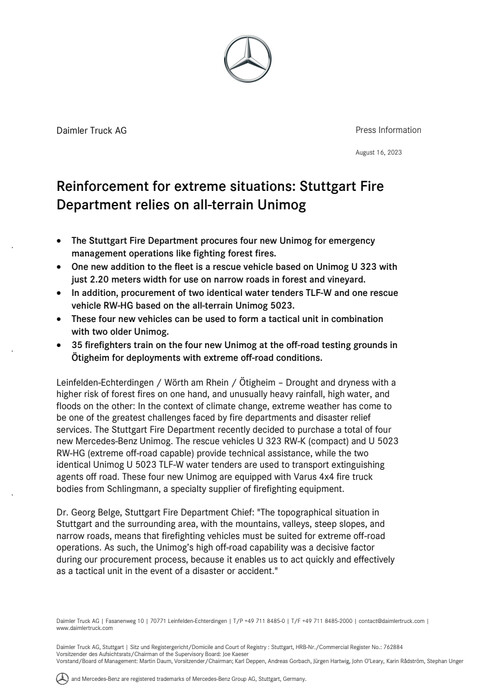
Reinforcement for extreme situations: Stuttgart Fire Department relies on all-terrain Unimog

Reinforcement for extreme situations: Stuttgart Fire Department relies on all-terrain Unimog

Reinforcement for extreme situations: Stuttgart Fire Department relies on all-terrain Unimog

Reinforcement for extreme situations: Stuttgart Fire Department relies on all-terrain Unimog

Reinforcement for extreme situations: Stuttgart Fire Department relies on all-terrain Unimog

Reinforcement for extreme situations: Stuttgart Fire Department relies on all-terrain Unimog

Reinforcement for extreme situations: Stuttgart Fire Department relies on all-terrain Unimog

Reinforcement for extreme situations: Stuttgart Fire Department relies on all-terrain Unimog

Reinforcement for extreme situations: Stuttgart Fire Department relies on all-terrain Unimog

Lukas Hettmannsperger
Spokesperson Mercedes-Benz Special Trucks
lukas.hettmannsperger@daimlertruck.com
+49 170 3871112

Ulrike Burkhart
Spokesperson Mercedes-Benz Trucks Product, Service & eTruck
ulrike.burkhart@daimlertruck.com
+49 160 861 3757

















